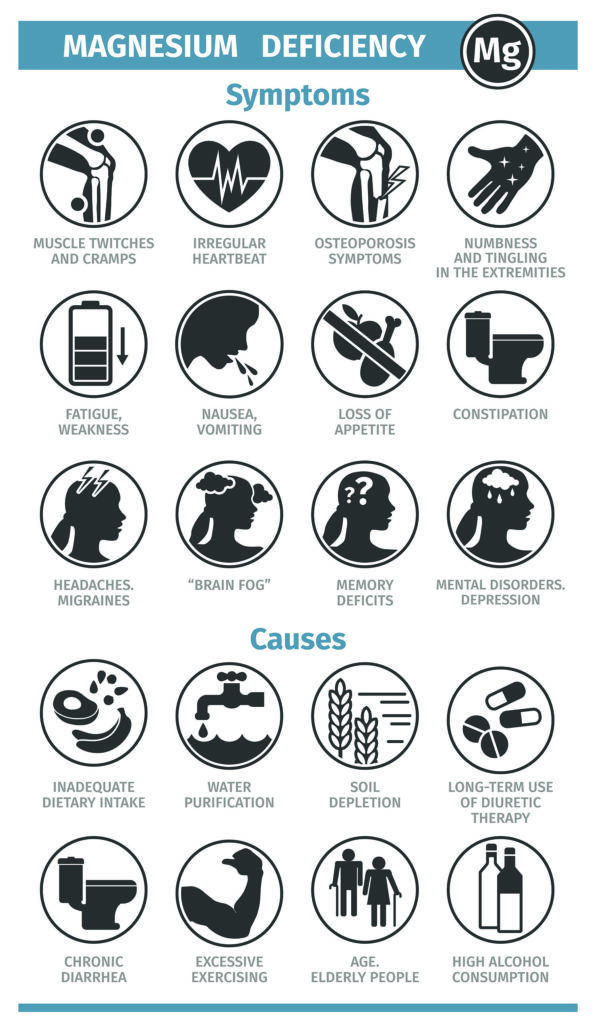Magnesium is known to participate in over 300 enzymatic reactions in the body. Recent research has identified 3,751 binding sites for magnesium on human proteins, which could be crucial in understanding how human complexity emerges from so few genes.
On a more technical level, magnesium is an essential NMDA receptor modulator, regulating the actions of the excitatory neurotransmitter glutamate. It is also critical for producing cellular energy (ATP) and SAMe, the body’s major methyl donor and precursor to essential agents like neurochemicals, fatty acids, and antioxidants. In many ways, having adequate magnesium allows the body to function optimally.
Magnesium’s Link to Depression, Anxiety, PMS, Headaches, and Women’s Health

Magnesium has been demonstrated to be a rapidly effective intervention for depression, likely related to its role in regulating neuronal function through calcium flux in and out of cells and potentially its role in optimal thyroid function—an underactive thyroid is a known cause of depression (Serefko et al., 2016). Magnesium deficiency has also been linked to an increased risk of developing osteoporosis in postmenopausal women (Orchard et al., 2014).
In a randomized, blinded, cross-over trial, magnesium with B6 was effective in relieving PMS-related anxiety and menstrual migraines (De Souza et al., 2000). Similarly, women with PMS experienced improvement in mood and pain by the second month of treatment with magnesium in a randomized, controlled trial (Facchinetti et al., 1991).
When women have low magnesium levels during their menstrual cycle, they enter pregnancy depleted (up to 70% of women do), go on to deliver and breastfeed, and the cumulative deficiency may play an essential role in the onset of postpartum depression.
Magnesium may also have anti-inflammatory properties, as demonstrated in a study of women consuming the mineral through dietary sources (Song et al., 2005). Furthermore, magnesium is crucial for Vitamin D absorption, as it helps convert the vitamin into its active form (Uwitonze & Razzaque, 2018).

How to Take Magnesium
Magnesium can be found in leafy green vegetables, nuts, and seeds. It is notably depleted by stress, alcohol, sugar, and sodas (high in phosphoric acid).
The Recommended Dietary Allowance for women goes up as they age, ranging from 360 mg in the teenage years to 310mg for the elderly. However, women who are pregnant or lactating can benefit from higher doses of up to 400 mg.
My preferred product is a multi-formula, Magnesium Essentials, that has three unique forms of highly absorbed magnesium to ensure maximum absorption of this important macromineral. Most magnesium supplements use only a single source of magnesium, which can easily overwhelm a single pathway of absorption and limit the uptake of high-dose magnesium regimens.
Dividing doses throughout the day (say, with each meal) may be helpful if you experience loose stools, but magnesium may have a calming effect that is preferable at night.
For my patients struggling with insomnia, incorporating an Epsom salt bath into their nightly ritual helps warm the body and provides a healthy dose of this sought-after mineral.
Conventional doctors are well aware of the power of this nutrient—it’s used in hospitals for constipation, heart arrhythmias, seizures, and contractions in pregnancy—but they seem to forget about it when they sit down behind their desks in the office. Use this information to experience the power of nature’s natural relaxant and better understand the unique health needs of women.
It is essential to recognize that women’s health requirements can differ from those of men. Historically, most studies have focused on men, leaving gaps in our understanding of women’s specific health needs. By acknowledging these differences and incorporating additional research on magnesium, we can better appreciate its vital role in women’s health, from depression and PMS to Vitamin D absorption. By adopting a balanced diet rich in magnesium and considering supplementation when necessary, women can support their overall health and well-being.
Incorporating Magnesium Into Your Daily Life
It’s important to prioritize magnesium intake through your diet and, if necessary, supplements. Consuming magnesium-rich foods, such as leafy greens, nuts, seeds, and whole grains, can help you maintain adequate magnesium levels. Additionally, reducing stress, alcohol consumption, and sugary drink intake can help prevent magnesium depletion.
When considering magnesium supplements, consult a healthcare professional to determine the appropriate dosage and form for your specific needs. Remember that individual magnesium requirements may vary, especially in women, due to factors such as age, hormonal fluctuations, and pregnancy.
Regularly monitoring your magnesium levels can also help ensure you’re maintaining an optimal balance. By understanding the unique health needs of women, including the importance of magnesium, we can support overall well-being and address conditions such as depression, anxiety, PMS, and headaches.
In summary, recognizing and addressing the unique health needs of women is essential for optimal well-being. By understanding the importance of magnesium in women’s health and incorporating it into daily life, we can better appreciate its numerous benefits and bridge the research gap.
Sources:





















